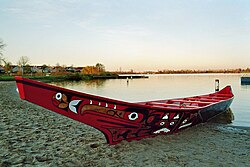Difference between revisions of "AY Honors/Canoe Building/Answer Key"
| Line 15: | Line 15: | ||
==Africa== | ==Africa== | ||
The well-watered [[Tropical rainforests|tropical rainforest]] and [[Miombo|woodland]] regions of sub-Saharan Africa provide both the waterways and the trees for dugout canoes, which are commonplace from the [[Limpopo River basin]] in the south through [[East Africa|East]] and [[Central Africa]] and across to [[West Africa]]. [[African Teak]] is the timber favoured for their construction, though this comprises a number of different species, and is in short supply in some areas. Dugouts are paddled across deep lakes and rivers or punted through channels in swamps (see ''[[Makoro|makoro]]'') or in shallow areas, and are used for transport, fishing and hunting, including, in the past, the very dangerous [[Water Transport in Zambia#Dugout canoes|hunting of hippopotamus]]. Dugouts are called [[pirogue]]s in [[Francophone]] areas of Africa. | The well-watered [[Tropical rainforests|tropical rainforest]] and [[Miombo|woodland]] regions of sub-Saharan Africa provide both the waterways and the trees for dugout canoes, which are commonplace from the [[Limpopo River basin]] in the south through [[East Africa|East]] and [[Central Africa]] and across to [[West Africa]]. [[African Teak]] is the timber favoured for their construction, though this comprises a number of different species, and is in short supply in some areas. Dugouts are paddled across deep lakes and rivers or punted through channels in swamps (see ''[[Makoro|makoro]]'') or in shallow areas, and are used for transport, fishing and hunting, including, in the past, the very dangerous [[Water Transport in Zambia#Dugout canoes|hunting of hippopotamus]]. Dugouts are called [[pirogue]]s in [[Francophone]] areas of Africa. | ||
| − | + | lsjkfhalivhsghsi;bns;oifnjbpsrjnbg;snb;lsrgnb;ksgrnbh;srjhgbpsfjg;ksfjhs;ornj;dfmh;srfjh;sfj;gh | |
| − | + | == Headline text == | |
| + | tyee6tyuer67uiryi<nowiki>Insert non-formatted text here</nowiki>utryuryi#REDIRECT [[Insert text]]yujr--[[User:203.91.94.251|203.91.94.251]] 06:56, 4 May 2007 (UTC)ty<sup>Superscript text</sup>ytu | ||
==Indigenous Peoples of North America== | ==Indigenous Peoples of North America== | ||
Revision as of 06:56, 4 May 2007
A dugout is a boat which is basically a hollowed tree trunk. Other names for this type of boat are logboat and monoxylon. Monoxylon (pl: monoxyla) is Greek -- mono (single) + xylon (tree) -- and is mostly used in classic Greek texts.
Dugouts are the oldest boats archaeologists have found. In Germany they are called Einbaum (English translation: One tree). Einbaum dug-out boat finds in Germany date back to the Stone Age. Along with bark and hide canoes, these dugout boats were used by American Indians. This is probably because they are made of massive pieces of wood, which tend to preserve better than, e.g., bark canoes.
Construction
Construction of a dugout begins with the selection of a log of suitable dimensions. Sufficient wood needed to be removed to make the vessel relatively light in weight and buoyant, yet still strong enough to support the crew and cargo. Specific types of wood were often preferred based on their strength, durability, and weight. The shape of the boat is then fashioned to minimize drag, with sharp ends at the bow and stern.
First the bark is removed from the exterior. Before the appearance of metal tools, dugouts were then hollowed-out using controlled fires. The burnt wood was then removed using an adze. Another method using tools is to chop out parallel notches across the interior span of the wood, then split out and remove the wood from between the notches. Once hollowed out, the interior was dressed and smoothed out with a knife or adze.
For travel in the rougher waters of the ocean, dugouts can be fitted with outriggers. One or two smaller logs are mounted parallel to the main hull by long poles. In the case of two outriggers, one is mounted to either side of the hull.
Africa
The well-watered tropical rainforest and woodland regions of sub-Saharan Africa provide both the waterways and the trees for dugout canoes, which are commonplace from the Limpopo River basin in the south through East and Central Africa and across to West Africa. African Teak is the timber favoured for their construction, though this comprises a number of different species, and is in short supply in some areas. Dugouts are paddled across deep lakes and rivers or punted through channels in swamps (see makoro) or in shallow areas, and are used for transport, fishing and hunting, including, in the past, the very dangerous hunting of hippopotamus. Dugouts are called pirogues in Francophone areas of Africa. lsjkfhalivhsghsi;bns;oifnjbpsrjnbg;snb;lsrgnb;ksgrnbh;srjhgbpsfjg;ksfjhs;ornj;dfmh;srfjh;sfj;gh
Headline text
tyee6tyuer67uiryiInsert non-formatted text hereutryuryi#REDIRECT Insert textyujr--203.91.94.251 06:56, 4 May 2007 (UTC)tySuperscript textytu
Indigenous Peoples of North America
The [[I am really gay hahahahahahahahaha
Pacific Islands
In the Pacific Islands, dugout canoes are very large, made from whole mature trees and fitted with outriggers for increased stability in the ocean, and were once used for long-distance travel. Such are the very large waka used by Māori who ventured to New Zealand many centuries ago. Such vessels carried 40 or 50 warriors in sheltered waters or smaller numbers thousands of miles across the Pacific ocean. In Hawaii, canoes are traditionally manufactured from the trunk of the koa tree. They typically carry a crew of six: one steersman and five paddlers.
i want to have sex with you tomorrow
References
External links
Template:Sailing vessels and rigs
cs:Monoxyl de:Einbaum es:Cayuco eo:Trunkoboato fr:Monoxyle is:Eintrjáningur nl:Boomstamkano



